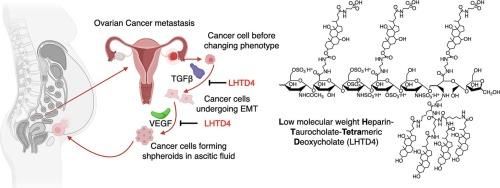低分子量肝素衍生物水平阻断转移性生长因子信号传导控制卵巢癌进展
IF 11.5
1区 医学
Q1 CHEMISTRY, MULTIDISCIPLINARY
引用次数: 0
摘要
传统的卵巢癌治疗包括手术,放疗/化疗,以及针对信号通路的靶向治疗,如转化生长因子-β (tgf -β)和血管内皮生长因子(VEGF)。然而,由于激活替代途径和缺乏患者反应,靶向治疗经常失败。因此,由于其结构刚性和均匀性,使用单一靶向治疗同时阻断多个途径(称为水平途径)是很难实现的。肝素巨大的结构多样性允许它通过结合肝素结合域与许多蛋白质结合并调节它们。在这里,我们的目的是通过使用低分子量肝素为基础的化合物与7个牛磺胆酸和四聚体去氧胆酸(LHTD4)偶联来解决水平靶向方法的局限性。LHTD4作为一种口服活性抗血管生成药物,可有效抑制卵巢癌进展中至关重要的VEGF和TGFβ通路。LHTD4显著降低SKOV3细胞中TGFβ和VEGF受体磷酸化,减弱emt基因,抑制恶性球体形成。在原位和腹膜卵巢癌转移小鼠模型中,LHTD4抑制肿瘤生长和转移,延长生存期,阻止恶性腹水形成。LHTD4阻断水平通路的能力为在不同进展阶段阻止卵巢癌转移提供了一种有希望的治疗策略。本文章由计算机程序翻译,如有差异,请以英文原文为准。


Horizontal blocking of metastatic growth factors signaling by low molecular weight heparin derivative to control ovarian cancer progression
Conventional ovarian cancer treatments include surgery, radio/chemotherapy, and targeted therapies aimed at signaling pathways like transforming growth factor-β (TGFβ) and vascular endothelial growth factor (VEGF). However, targeted therapies often fall short due to the activation of alternative pathways and lack of patient responses. Thus, the use of a single targeted therapeutic to block more than one pathway simultaneously, termed as horizontal pathways, is hard to achieve due to their structural rigidity and uniformity. Heparin's vast structural diversity allows it to bind with and regulate many proteins via binding to their heparin-binding domains. Here, we aim to address the limitation of horizontal targeting approach by using a low molecular weight heparin-based compound conjugated with seven taurocholic and tetrameric deoxycholic acids (LHTD4). LHTD4 has shown promise as an orally active anti-angiogenic agent, effectively inhibiting VEGF and TGFβ pathways crucial for ovarian cancer progression. LHTD4 significantly reduced TGFβ and VEGF receptor phosphorylation in SKOV3 cells, attenuated EMT-genes, and suppressed malignant spheroid formation. In mouse models of orthotopic and peritoneal ovarian cancer metastasis, LHTD4 decreased tumor growth and metastasis, prolonged survival, and prevented malignant ascites formation. LHTD4's ability to block horizontal pathways offers a promising therapeutic strategy to halt ovarian cancer metastasis at different stages of progression.
求助全文
通过发布文献求助,成功后即可免费获取论文全文。
去求助
来源期刊

Journal of Controlled Release
医学-化学综合
CiteScore
18.50
自引率
5.60%
发文量
700
审稿时长
39 days
期刊介绍:
The Journal of Controlled Release (JCR) proudly serves as the Official Journal of the Controlled Release Society and the Japan Society of Drug Delivery System.
Dedicated to the broad field of delivery science and technology, JCR publishes high-quality research articles covering drug delivery systems and all facets of formulations. This includes the physicochemical and biological properties of drugs, design and characterization of dosage forms, release mechanisms, in vivo testing, and formulation research and development across pharmaceutical, diagnostic, agricultural, environmental, cosmetic, and food industries.
Priority is given to manuscripts that contribute to the fundamental understanding of principles or demonstrate the advantages of novel technologies in terms of safety and efficacy over current clinical standards. JCR strives to be a leading platform for advancements in delivery science and technology.
 求助内容:
求助内容: 应助结果提醒方式:
应助结果提醒方式:


